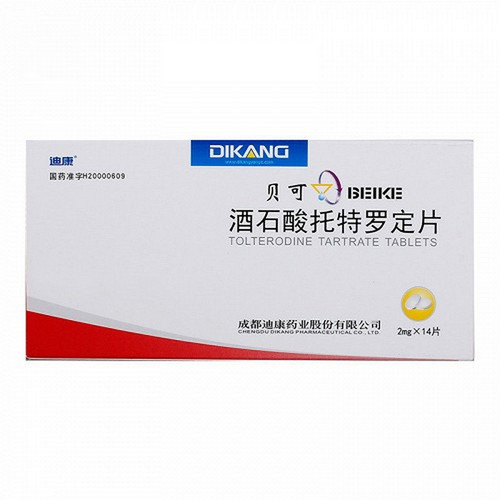Product Overview
[Drug Name]
Generic Name: Solifenacin Succinate Tablets
Trade Name: ShuLeBao Solifenacin Succinate Tablets 5mg*10 Tablets
Pinyin Code: ShuLeBao ZuoZuoSuanSuoLiNaXin Tablets 5mg*10 Tablets
[Main Ingredient]
Chemical Name: Solifenacin Succinate (3R)-1-azabicyclo[2.2.2]octan-3-yl (1S)-1-phenyl-3,4-dihydroisoquinoline-2(1H)-carboxylate Monosuccinate
Molecular Formula:C23H26N202·C4H6O4
Molecular Weight: 480.55
[Properties]
This product is a film-coated tablet that appears white or off-white after removal of the coating.
[Indications/Main Functions]
For the treatment of urinary incontinence and/or urinary frequency and urgency in patients with overactive bladder.
[Specifications]
5mg*10 tablets
[Dosage and Administration]
The recommended dose of this product is one 5mg tablet once daily, which can be increased to two 10mg tablets once daily if necessary. This product must be taken whole with water and can be taken before or after meals.
Renal Impairment: Patients with mild to moderate renal impairment (creatinine clearance >30ml/min) do not require dosage adjustment. Patients with severe renal impairment (creatinine clearance ≤30ml/min) should use this product with caution, with a dosage not exceeding 5mg daily.
Hepatic Impairment: Patients with mild hepatic impairment do not require dosage adjustment. Patients with moderate hepatic impairment (Child-Pugh score 7 to 9) should use this product with caution, with a dosage not exceeding 5mg once daily.
When potent cytochrome P450 3A4 inhibitors are used concomitantly with ketoconazole or therapeutic doses of other potent CYP3A4 inhibitors such as ritonavir, nelfinavir, and itraconazole, the maximum dose of this product should not exceed 5mg.
[Adverse Reactions]
See package insert for details.
[Contraindications]
This product should not be used in patients with urinary retention, severe gastrointestinal disease (including toxic megacolon), myasthenia gravis, or narrow-angle glaucoma, or in patients at risk for the following: patients with hypersensitivity to the active ingredient or excipients of this product; patients undergoing hemodialysis; patients with severe hepatic dysfunction; and patients with severe renal or moderate hepatic dysfunction who are taking strong CYP3A4 inhibitors such as ketoconazole.
[Precautions]
Before using this product, other causes of frequent urination (heart failure or renal disease) should be identified. If a urinary tract infection is present, appropriate antimicrobial therapy should be initiated. Caution should be exercised in the following patients: those with clinically significant lower urinary tract obstruction and risk of urinary retention; those with obstructive gastrointestinal disease; those at risk of decreased gastrointestinal motility; those with severe renal impairment (creatinine clearance ≤30 ml/min; see [Dosage and Administration] and [Pharmacokinetics]); in these patients, the dose should not exceed 5 mg once daily; those with moderate hepatic impairment (Child-Pugh score 7 to 9; see [Dosage and Administration] and [Pharmacokinetics]); in these patients, the dose should not exceed 5 mg once daily; those taking potent cytochrome P450 3A4 inhibitors such as ketoconazole; see [Dosage and Administration] and [Drug Interactions]; those with hiatal hernia/gastroesophageal reflux and/or those taking medications that can cause or exacerbate esophagitis (e.g., bisphosphonates); and those with autonomic nervous system disorders. QT prolongation and torsades de pointes have been observed in patients with risk factors (e.g., preexisting long QT syndrome and hypokalemia). The safety and efficacy of this medication in patients with neurogenic detrusor overactivity have not been established. This medication should not be used in patients with rare hereditary conditions such as galactose intolerance, Lapp lactase deficiency, or glucose-galactose malabsorption. Angioedema with airway obstruction has been reported in some patients after using this medication. If angioedema occurs, this medication should be discontinued and appropriate treatment and/or measures should be instituted. Hypersensitivity reactions have been reported in some patients after using solifenacin succinate. In patients who experience hypersensitivity reactions, solifenacin succinate should be discontinued and appropriate treatment and/or measures should be instituted. The maximum efficacy of this medication can be determined as early as 4 weeks after administration. Effects on driving and operating machinery: Like other anticholinergic drugs, solifenacin may cause blurred vision, drowsiness, and (rarely) fatigue (see Adverse Reactions), which may negatively affect driving and operating machinery.









